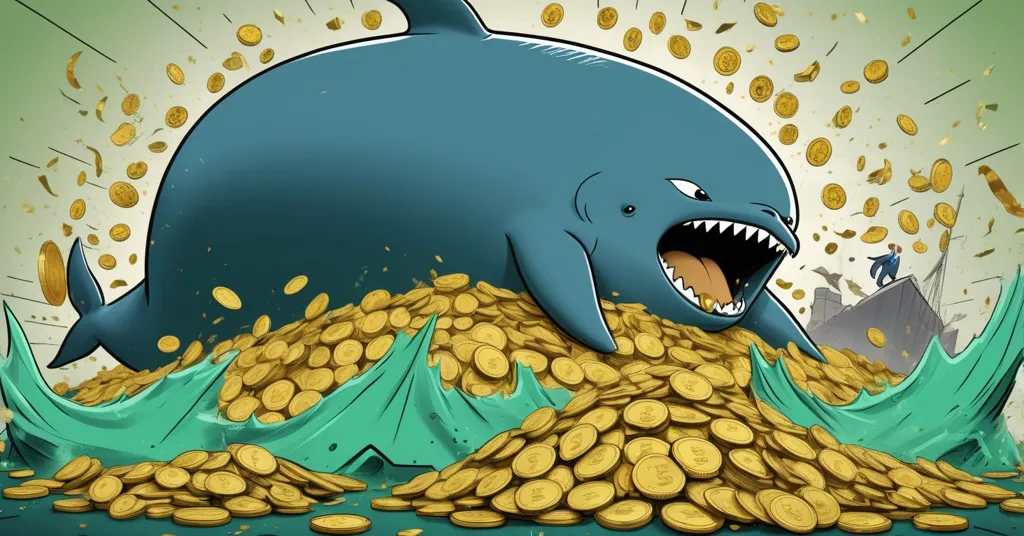Dogecoin Whale Dump: $440M Sell-Off Sparks Price Crash Fears in 2023

Dogecoin’s $440M Whale Dump: Price Crash or Hidden Recovery in 2023?
Dogecoin (DOGE), the meme coin that once rode waves of social media hype to staggering heights, has been hit hard by a staggering $440 million sell-off from large investors, known as whales, in just 72 hours before Halloween. This brutal dump has shattered market confidence, raising serious questions about whether DOGE can survive this latest blow or if it’s a grim signal of a deeper collapse in the meme coin space.
- Whale Sell-Off Shock: $440M in DOGE dumped by major investors in 72 hours.
- Bearish Warning: Price could tank to $0.07, obliterating recent gains.
- Recovery Glimmer: A 190% rally to $0.50 possible if bullish momentum returns.
The Fallout of the Whale Dump
The sheer scale of this $440 million sell-off has sent Dogecoin reeling, with the price failing to hold a crucial support level at $0.18. For those new to crypto, a support level is a price point where a coin typically sees enough buying interest to halt a decline. When it breaks, as it did here, it often spells trouble ahead. Analysts are now sounding the alarm, with predictions of DOGE sliding to as low as $0.07—a drop that would gut much of the gains made in recent months. That’s not just a dip; it’s a nosedive into the abyss for DOGE holders. Intermediate price floors at $0.12 and $0.09 might offer temporary relief if buyers step in, but the sentiment is undeniably bearish.
What’s driving this carnage? Technical indicators aren’t painting a pretty picture. The MACD histogram, a tool that tracks price momentum, is signaling a fresh downtrend, suggesting the bleeding might not stop soon. While whales dumping massive holdings often points to profit-taking after a rally, it could also hint at deeper concerns—perhaps fears of regulatory crackdowns or a broader loss of faith in meme coins’ staying power. Without transparency into whale motivations, we’re left speculating, but one thing is clear: when big players cash out, retail investors are often left holding the bag. For more insight into this massive sell-off, check out this detailed analysis on the recent Dogecoin whale dump.
Community Sentiment and Historical Context
Dogecoin’s community—once a vibrant, meme-fueled army on platforms like Reddit and Twitter—now finds itself at a crossroads. Scrolling through online forums, you’ll see a split: some diehards are doubling down, chanting “HODL” and banking on another Elon Musk tweet to save the day, while others are cutting losses, disillusioned by the volatility. This isn’t the first time DOGE has faced the brink. Cast your mind back to 2021, when Reddit-driven hype and celebrity endorsements during the GameStop saga sent DOGE soaring over 8,000% at its peak. But what goes up must come down, and each crash has tested the resolve of its fanbase. Is this $440 million dump just another bump in the rollercoaster, or the final straw for a coin built on little more than internet jokes?
Historically, DOGE has a knack for defying the odds, rising like a meme-powered phoenix from the ashes of despair. But relying on hype cycles alone is a shaky foundation. Whale movements like this expose a harsh truth: despite crypto’s promise of decentralization, a few deep-pocketed players can still tank a market in an instant. Are meme coins like DOGE truly pushing financial sovereignty, or just decentralizing who gets burned in the inevitable crashes?
A Glimmer of Hope for Recovery?
Amid the doom, there’s a sliver of optimism for DOGE enthusiasts. The Relative Strength Index (RSI), a momentum gauge that shows if a coin is overbought or oversold, is hovering near the oversold mark of 30. In the past—think late 2020 or mid-2022—when DOGE hit this level, it often marked the bottom of a correction, followed by a sharp rebound. If bullish winds pick up, some analysts see a potential 190% rally to $0.50 on the horizon. That’s not pure fantasy; external factors could play a role. Easing U.S. interest rates often boosts risk appetite, funneling capital into speculative assets like meme coins. Add to that the buzz around spot DOGE ETFs—exchange-traded funds that let mainstream investors bet on Dogecoin without owning it directly—and you’ve got a recipe for renewed demand.
But let’s not get carried away. These are massive “ifs” in a market as unpredictable as a dice roll. ETFs face regulatory hurdles, and macro conditions can flip overnight. Plus, even if DOGE bounces, can it sustain momentum without real utility beyond being a punchline? Bitcoin, by contrast, holds firm as a store of value with a clear decentralized ethos—reminding us why fundamentals matter when the hype fades.
Meme Coin Reckoning: A Sector Under Fire
Dogecoin’s struggles aren’t an isolated incident; they reflect a broader reckoning in the meme coin niche. From Shiba Inu, which has seen its own price erode after 2021’s meteoric rise, to countless failed copycats, the sector is facing a harsh winter of sentiment. Investors are waking up to the reality that speculative fervor—often fueled by social media and celebrity nods—doesn’t equate to long-term value. Frankly, it’s a gut check the meme coin space desperately needed. No more free rides on viral tweets; the market is demanding substance.
That said, let’s play devil’s advocate. Despite their flaws, meme coins have a silver lining—they’ve onboarded millions into crypto. DOGE, with its low entry price and quirky branding, has been a gateway for newcomers to grasp blockchain basics, even if through a “joke” lens. Isn’t that a win for decentralization, even if messy? The counterargument is stark: onboarding is meaningless if it ends in rug pulls or whale-driven dumps that sour trust in the entire space. The jury’s still out on whether meme coins are a net positive or a distracting sideshow.
Market Shift: From Hype to Utility
As meme coins falter, a noticeable pivot is underway. Investors, burned by volatility, are rotating capital into projects with tangible value. Take SUBBD ($SUBBD), for instance—an AI-powered content platform that’s garnered attention for raising nearly $1 million in its presale phase. Unlike DOGE’s speculative fluff, SUBBD focuses on decentralizing content monetization, letting creators and fans connect via token-gated access without centralized middlemen. It’s a nod to crypto’s roots: user sovereignty and shared value over blind hype. While its success isn’t guaranteed, it highlights a maturing market hungry for utility over memes.
This shift isn’t just about one project; it’s a broader trend. The crypto space is outgrowing its Wild West phase of pump-and-dump schemes. Whether it’s decentralized finance (DeFi) protocols or blockchain-based solutions like SUBBD, the focus is turning to real-world impact. Dogecoin’s whale dump might just be the wake-up call needed to steer us back toward disruption and freedom—core pillars of why crypto exists in the first place.
What’s Next for Dogecoin and Beyond?
This $440 million whale dump is a brutal reminder of crypto’s volatility and the outsized influence of big players. For Dogecoin, the road ahead is murky—will it crumble to $0.07, or defy critics with a moonshot to $0.50? More importantly, it forces us to confront what we value in this space. Are we chasing quick flips and internet gags, or building a decentralized future that upends broken financial systems? Perhaps it’s a bit of both, but as DOGE holders brace for impact, the market’s evolution away from blind speculation feels inevitable.
Bitcoin maximalists might smirk at DOGE’s plight, pointing to BTC’s stability and ethos as the true north of crypto. Yet, altcoins and innovative protocols—Ethereum’s smart contracts, or even niche utility tokens—fill gaps Bitcoin doesn’t aim to serve. Dogecoin’s drama, while messy, underscores the diversity of this financial revolution. It’s not just about one coin; it’s about accelerating toward a freer, more open system—no bullshit, no scams, just raw potential and hard lessons.
Key Takeaways and Questions
- What triggered the $440 million Dogecoin whale dump?
Large investors likely took profits or lost confidence in DOGE’s short-term outlook, unloading $440 million in a 72-hour spree before Halloween, hammering market sentiment. - How low could Dogecoin’s price fall after this sell-off?
Analysts warn of a potential crash to $0.07, with key price floors at $0.12 and $0.09 possibly acting as buffers if buyers emerge to slow the descent. - Is a Dogecoin recovery on the cards, and what might drive it?
A 190% surge to $0.50 is possible if bullish momentum kicks in, fueled by an oversold RSI, U.S. interest rate cuts, and potential spot DOGE ETF approvals. - Why are investors turning away from meme coins like Dogecoin?
Frustration with wild price swings and lack of utility is pushing capital toward projects with real-world impact, signaling a market tired of hype without substance. - How do whale dumps affect smaller crypto investors?
These massive sell-offs shatter confidence and often spark panic selling among retail players, leaving them with heavy losses while whales exploit the chaos. - What does this mean for the future of meme coins in crypto?
The sector faces a reckoning as speculative fervor fades; survival may hinge on finding utility or community strength, otherwise, they risk becoming relics of hype cycles.



